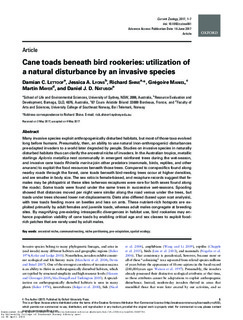| dc.description.abstract | Many invasive species exploit anthropogenically disturbed habitats, but most of those taxa evolved long before humans. Presumably, then, an ability to use natural (non-anthropogenic) disturbances pre-adapted invaders to a world later degraded by people. Studies on invasive species in naturally disturbed habitats thus can clarify the ancestral niche of invaders. In the Australian tropics, metallic starlings Aplonis metallica nest communally in emergent rainforest trees during the wet-season, and invasive cane toads Rhinella marina join other predators (mammals, birds, reptiles, and other anurans) to exploit the food resources beneath those trees. Compared to conspecifics found along nearby roads through the forest, cane toads beneath bird-nesting trees occur at higher densities, and are smaller in body size. The sex ratio is female-biased, and recapture records suggest that fe- males may be philopatric at these sites (whereas recaptures were rare for both sexes found along the roads). Some toads were found under the same trees in successive wet-seasons. Spooling showed that distances moved per night were similar along the road versus under the trees, but toads under trees showed lower net displacements. Diets also differed (based upon scat analysis), with tree toads feeding more on beetles and less on ants. These nutrient-rich hotspots are ex- ploited primarily by adult females and juvenile toads, whereas adult males congregate at breeding sites. By magnifying pre-existing intraspecific divergences in habitat use, bird rookeries may en- hance population viability of cane toads by enabling critical age and sex classes to exploit food- rich patches that are rarely used by adult males | nb_NO |

